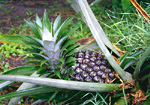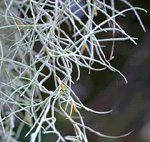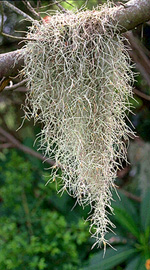 |
No bromeliads are native to Australia, and only two species (the pineapple Ananas comosus and the epiphytic Tillandsia) are occasionally naturalised or persist after cultivation in coastal Queensland. Almost all species are native to tropical South America.
Characteristic features of the family Bromeliaceae in Australia include:
- plants with narrow, sword-shaped, usually toothed leaves, usually
with a greyish covering of small, peltate scales
- flowers in spikes, actinomorphic, with two whorls of 3 parts each, red, violet or green, each flower enclosed at base by a prominent bract
- stamens 6; ovary with numerous ovules
Description
Perennial terrestrial herbs or epiphytes perennating by rhizomes.
Vegetative reproduction by detached stem parts or bulbils. Internal secretions
not obvious. Plants with peltate scales. Leaves alternate and spiral,
or distichous, cauline or all or mostly basal, sessile. Stipule-like lobes
absent. Lamina simple, symmetric, filiform, acicular, subulate or linear;
base attenuate; margins entire or serrate, ±flat, involute or incurved;
venation parallel, with the midrib inconspicuous, the tertiary venation
not reticulate; surfaces not punctate; herbaceous or leathery. Leaf ligule
absent.
Plants with all the flowers bisexual. Inflorescences terminal, consisting of spikes or solitary flowers. Bracts present. Pollination by insects or birds. Flowers odourless; sessile. Floral disc absent; nectaries present on the carpels. Perianth regular, of 2 dissimilar whorls, imbricate in bud. Calyx segments free, with 3 sepals, herbaceous or succulent. Corolla segments free, with 3 petals, alternating with the sepals, orange, red or magenta, purple or violet; without contrasting markings, membranous; claws absent; lobes ±entire. Fertile stamens 6, opposite to the sepals, at least partly fused to corolla, free of the ovary and style, distinct from each other, all ±equal. Staminodes present or absent. Anthers basifixed, not versatile, opening inwards by longitudinal slits; 2-celled. Ovary superior and sessile or inferior. Carpels 3, fused; ovary with 3 locules. Style terminal, single and branched above. Ovules numerous per locule, stalked; placentation axile. Fruit dry or fleshy, dehiscent or indehiscent, a septicidal capsule; rarely a fleshy composite fruit; the perianth on the maturing fruit dry and persistent or growing larger. Disseminule macro-surface featureless or with straight hairs; micro-surface ±smooth, white, yellow or orange, dull. Seeds 1–numerous per fruit. Aril absent. Cotyledons 1. Embryo curved.
(Note: this description has been generated from the coded data compiled for the key. Any errors in the key data will be reflected in the descriptions.)
A treatment of the family Bromeliaceae has been published in:
Flora of Australia 45: 12-15.
Australian genera of Bromeliaceae (as recognised for the Flora of Australia)
* = all species introduced
*Ananas
*Tillandsia

|
  |

Ananas comosus (habit)
Photo: K.Thiele © ABRS

Tillandsia usneoides (flowering branch)
Photo: K.Thiele © ABRS

Tillandsia usneoides (habit)
Photo: K.Thiele © ABRS
|
 |
|